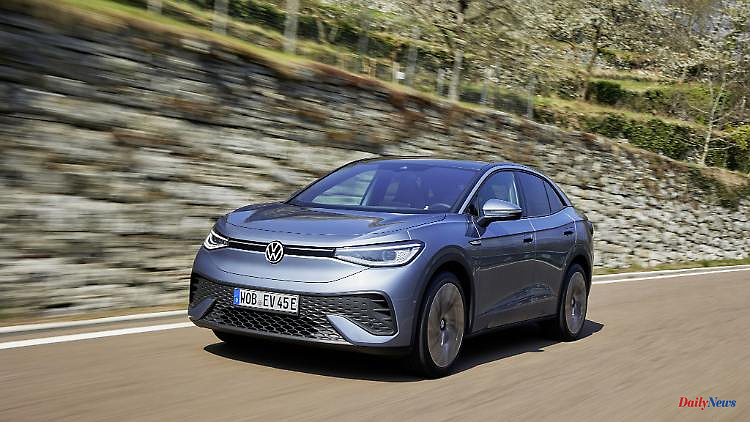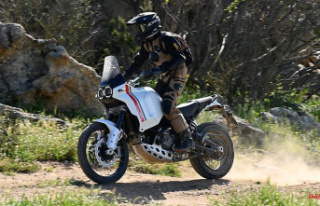If the ID.4 is not sporty enough for you, VW recommends the ID.5. As a distinctive coupé, the Wolfsburg Stromer is much more distinctive than its brother. However, it is based on the same modular system as the ID.4. Not only that has the consequence that the sport-oriented driver could be disappointed in the end.
The rule used to be that coupes cost more but offer less car than the corresponding sedans. The waiver of two doors had to be made palatable to coupe buyers. Today, many "coupés" are SUV derivatives and, of course, have four portals. Apart from the sloping roof line, there are often no or only a few differences within the model family.
This is also the case with the ID.5, which costs at least 46,515 euros without state funding - it is even slightly longer than the ID.4. Well, the one and a half centimeters more are rather negligible, since the two and a half centimeters lower roof line unfolds more optical effect - it makes the car appear stretched and therefore more athletic. The sportier of the two electric SUVs from Wolfsburg looks good.
Getting started is largely the same as with the ID.4. Unsurprisingly, Volkswagen has long since said goodbye to the classic instrument cluster in its ID series. Instead, the driver finds a separate display with large digits for the current speed - and that's also perfectly legible. Things like range in kilometers and battery charge level in percent also remain permanently visible, after all, both parameters are not entirely unimportant in battery-electric cars.
Logically, the user cannot tinker around with this ad, so he has to live out his play instinct somewhere else. This works much better on the central touchscreen, on which the wealth of vehicle functions can be operated quite intuitively, than on the steering wheel buttons, which do not always react precisely to the touch, and which are also used to control the cruise control. Volkswagen should make improvements here.
A shortcut to deactivate the active lane departure warning system more quickly would also be advisable. In practical use, it reacts to even the slightest deviation from the center line with harsh vibrations in the steering wheel, which is more of a nuisance than a help. Not every computer-assisted driving function makes sense in everyday use. On the other hand, the active cruise control including autonomous emergency braking is to be expressly commended. It not only increases driving comfort, but also safety.
Speaking of operation: Volkswagen has given up using the start button - as soon as you sit in the driver's seat and have the vehicle key with you, the ID.5 is ready. Press the brake and turn the right steering column element to "D", then the spacious SUV coupe crawls away.
The weakest representative for the moment is the sufficiently motorized ID.5 with 204 hp (47,550 euros without funding). The 174 hp variant will be launched later. However, the all-rounder equipped with rear-wheel drive is so heavy with a curb weight of 2.1 tons that despite a maximum torque of 320 Newton meters it is superior, but not particularly sporty. If you compare it to a diesel that is about as powerful, you should still find the electric model more elastic. The secret lies in the fixed translation. Change-speed gearboxes produce interruptions in tractive power, which are simply not the case with electric cars.
But Volkswagen still has a hotter version up its sleeve. The marketing department dug up a historical abbreviation for this - older contemporaries probably still remember the GTX versions of the Scirocco, which was on the road with 112 little horses until 1989. So now GTX again - ID.5 GTX to be more precise, but with an exciting 299 hp. However, one or the other performance fan might be disappointed when he drives the modern GTX for 53,615 euros into the 180 km/h limiter on the open road with a bang. It would then even have to be overtaken by the historic GTX, after all, this is in the papers with up to 204 km/h. And presumably its speedometer needle climbs the 220 mark with a lot of effort. Good keyword, you could have treated the electric GTX to 220 km/h, knowing full well that it is a very German perspective.
Let's enjoy the well-balanced ID.5, which, especially as a GTX with the two electric hearts, also allows striking lateral dynamics thanks to electronic contactor assistance and is not only fast in a straight line (6.3 seconds from 0 to 100 km/h). It's also nice that he doesn't subject his human cargo to excessive hardships, but rolls over bumps quite smoothly.
Shortly after the idea of covering long distances with the ID.5 - for which it is really predestined - the question immediately arises of how to get fresh energy again. The larger 77 kWh battery is mandatory, which means at least 425 kilometers WLTP range for the GTX and even 516 kilometers for the single engine edition. In general, it is also important to pay attention to the charging time of five to 80 percent battery level, recommends technician Andreas Lange. Volkswagen puts this at around half an hour.
Of course, high charging power can be specified, the engineer explains, but such a statement is of no help to the customer if it is only achieved for a short period of time. However, the Volkswagen engineer reveals that the ID.5 also packs the 170 kW at the charging station, although the group remains conservative with the factory specification, with 135 kW - so customers would not be disappointed either. If you want to be as efficient as possible on the road, you should not do without the 990 euro heat pump, which relieves the traction battery when heating is required. On the other hand, you shouldn't expect too much from it either, because only a little heat is lost when driving steadily on the freeway.
The ID.5 also offers two real delicacies, one of which could at least be tested on the spot: This allows parking processes that have been carried out with great effort to be saved. If you drive back to the previously marked spot later, the assistant takes over the parking automatically. Only the brake and accelerator pedals have to be operated. This even works with quite complex and winding parking maneuvers, which the system reproduces with virtuosity.
The EV route manager, which calculates optimal charging points, will still have to face extensive tests later. However, it is no longer so easy to get stranded with an electric car, at least in Germany. This is not least due to the meanwhile usable ranges of the vehicles, but also to the dense fast charging network, which does not have to hide in a European comparison.
6












